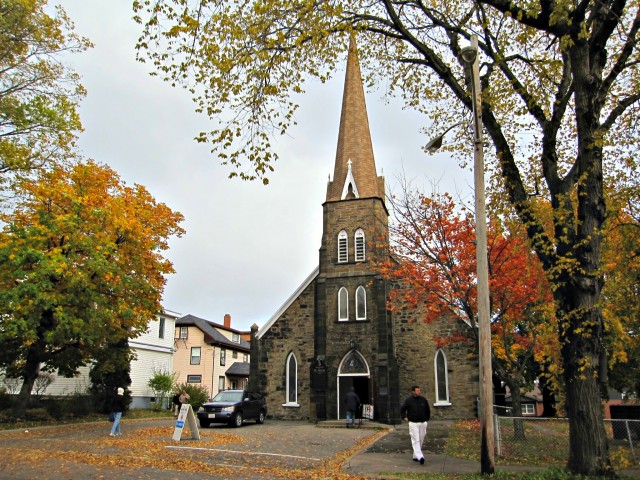I found the following clipping on Norma Deagle-MacPhee's Facebook Page...Journal Pioneer Newspaper - July 22, 1964
PIONEER SERVICE RECALLS LONG HISTORY OF CHURCH
TIGNISH- A centennial anniversary service honouring the early pioneers of Protestant church history in this part of the province, will be held at Tignish United Church, Sunday, July 26, 1964 at 2:30pm.
Worship will be conducted by the minister Rev. David S.H. MacDonald, who will also deliver the sermon, Special music will be sung by the Wilmot Church Quartette of Fredericton, N.B. Henry Clark of Alberton will be guest organist.
Protestant church history in Tignish dates back 104 years. The first church building was located one mile south west of where the present church stands.
Rev. Robert Dyer, the first Anglican clergyman to be settled in west Prince says in his journal that at Little Tignish a church was
built by the Episcopalians, Baptists, Presbyterians and Methodists and that he himself had the pleasure of opening the new church. The year would be either 1860 or 1861.
WEST CAPE CIRCUIT
Rev. Allan Fraser, minister of Alberton Presbyterian Church from 1855-1870 had under his care an area extending from Tignish to West Cape and in the years of Tignish congregation were Alexander Stewart, Thomas Haywood, Mrs. Josiah Hamill, Thomas Barbour, Mr. and Mrs. James Haywood, Daniel Miller, Alexander MacLeod and Carlyle Bell.
BUILT IN 1893
Erection of the present edifice was completed in 1893 and on July 2 of that year was dedicated. Communion at the afternoon service was conducted by Rev. James Murray assisted by Rev. David Sutherland of Charlottetown.
The land on which the new church was built was a gift of Mrs. Benjamin Haywood (nee Elizabeth Rodd) So far as can be learned the building was erected by J.M. Clark and Co. of Summerside. One of the carpenters in its employ at the time was Hensley Stavert who later became a Presbyterian minister. Bricks used for the foundation and flue were manufactured by Francis O. Hughes who operated a kiln just outside the village.
Ministers who served the congregation in Tignish were Rev. George Fisher 1884-1889; Rev. James Murray 1891-1895; Rev. A.D. MacDonald 1894-1903; Rev. W.A. MacKay 1905-1908; Rev. J.H. MacNattie 1909-1913; Rev. Emmanuel Lockhart 1914-1920; Rev. T.L. Williams 1921-1923.
SINCE CHURCH UNION
At the time of church union in 1925, a rearrangement of congregational boundaries resulted in Tignish becoming a part of Alberton Pastoral Charge. It’s ministers since then have been Rev. J.R. Miller 1926; Rev. A.S. Weir 1926-1934; Rev. George Ross 1934-1936; Rev. M.K. Charman 1936-1941; Rev. G.N. Somers 1941-1943; Rev. Murdock Fraser 1943-1948; Rev. P.A. Fitzpatrick 1948-1951; Rev. A.R. Wallis 1951-1954; Rev. Murray Gardiner 1954-1956; Rev. J.M. Sproule 1957-1958.
The charge was without a minister for eighteen months and during this period it was served by Elmer MacLean a laymen who is now studying for the ministry.
Rev. J.A. MacIntosh was minister in 1960-1961. The present minister Rev. David S.H. MacDonald was inducted as minister in July 1962.
About 18 years ago the exterior of the church was repaired and painted. In 1959 the interior of the church was completely redecorated.
In preparation for pioneer Sunday the interior of the church and grounds around the church have received a major clean-up. Within the past few years a number of gifts in honor of loved ones departed have been presented and dedicated.
Tignish Protestant Church began as a community church with its people of several denominational traditions working together to foster and promote the Christian spirit. After a century of service it is apparently still a community church proud of honour and pay respect to the early Pioneers who kept faith._________________________________
Below is an excerpt about the church from UPEI: Island LivesMethodists, Bible Christians And Presbyterians In Prince Edward Island: Campbellton-Miminegash. 1984. Warren W. Goss. Williams & Crue. Page 53.
"TIGNISH — To the people of Tignish, Church Union was nothing new. The first church in their community was built in 1861 by Episcopalians, Baptists, Presbyterians and Methodists. Use of this little church was discontinued in 1893 when a new one was built by the Presbyterians. This church also became a community one. In 1973, the building was turned over to the village of Tignish to be converted into a museum."
_________________________________
The church that preceded the above church was built just outside Tignish on the Christopher Road on the south side of Little Tignish River. Rev. R.W. Dyer officially opened the church in January 1860 as noted in his journal excerpt below. He called it "Omnibus Church". I've never been able to find references to this church name - it might have been called something else. "January 29, 1860... After the Morning Service, I took some refreshment and started off to Tignish to hold Service in the new church. I was not a little gratified to have the pleasure of opening this new building, especially as it has been built by all denominations, namely, Episcopalians, Presbyterians, Wesleyans, Baptists. Service commenced at 3 o'clock with singing, and then commenced our beautiful Service, and a sermon, Exoduc 20, and the 24th verse, which I had partly prepared for the purpose. After the Service we sang the evening hymn and closed the service of the day which was, I believe, enjoyed by the whole congregation. This is the first time since I came to this Mission that I have had a church in which to conduct services or to preach. it seemed a comfort and a great pleasure. if there should have been one soul born again at the service, it was but the place of the (re)birth of one sinner, besides a pleasure, what a mercy. "Laus Deo." After the service I went to see Mrs. Platts..."
Below: Photo of the former Omnibus Church site, the church is long gone - only a few stones remain in the cemetery - it's all grown up around it.


















































